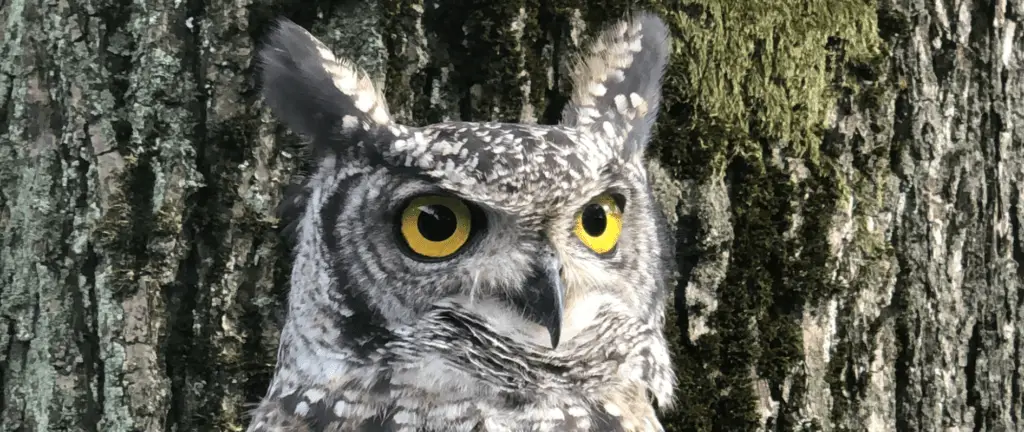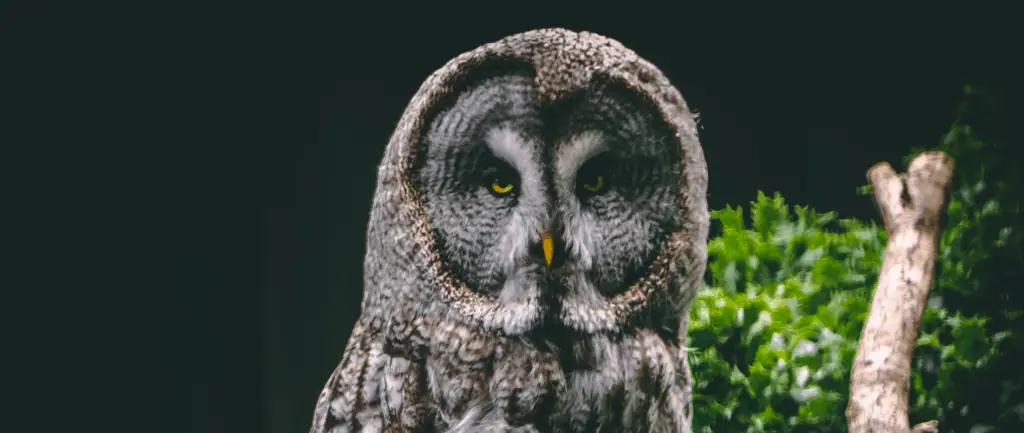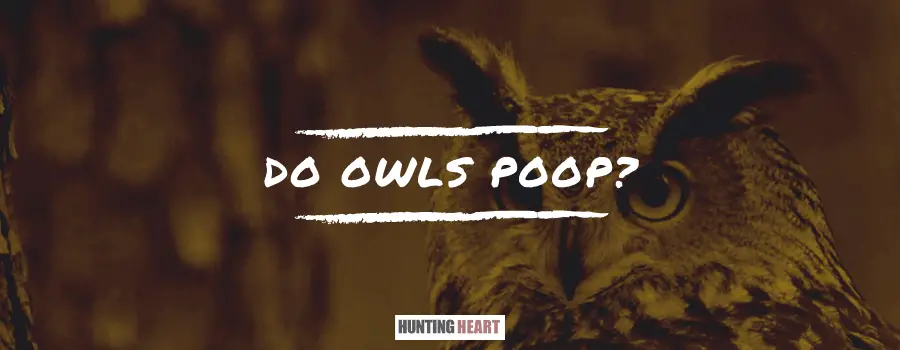As an Amazon Associate I earn from qualifying purchases.
Our Associate portal can be found here
If you’ve been lucky to observe an owl for some time, you’ll see how strange they go about their activities. They have a unique way of preening, sleeping, flying, and even hunting or consuming prey is. These birds of mystery, having unique ways of doing things, might cause you to wonder how do owls poop?
Yes, owls do poop. As a bird of prey, an owl consumes its prey whole. Digested food gets excreted through the back end, but what it can’t digest comes back up in form of pellets. Owl excrement is a mix of urine dissolved with urea, a thick white paste that soon turns grey and hardens.
Are curious about the toilet habits of your pet owl. Or do you want to be better informed so you’ll spot their presence in your barn? Keep reading as I dissect owl poop, how it’s formed and why some come back through the beak as pellets.
Is It Normal For Owls to Regurgitate Undigested Food as Pellets?
Owls aren’t alone in casting or regurgitating pellets, as so do most birds of prey that consume food whole. Besides owls, hawks, herons, eagles, falcons, cormorants, swallows, grebes, and kingfishers are also known to cast. The black-billed cuckoo, which eats mainly spiny caterpillars, can’t shed the spines. It gets rid of them by regurgitating its stomach lining as one large, spine-filled pellet.

For such birds, their digestion and excretion systems allow the bird to cast out or excrete through the mouth. Having no teeth, an owl swallows prey whole without chewing or tears larger critters into small pieces with their beak.
If you come across partially plucked mammals and birds, chances are an owl has been the successful predator. It’s after ingesting that the difference with other birds occurs, seeing as owls have no crop. That’s the loose sac found in a bird’s throat, where food is stored to be digested later. Without this feature, owls are forced to pass the food directly to their stomachs.
One common owl species, the barn owl, is notoriously known for swallowing its prey whole. These birds consume at least a thousand mice and other similarly sized rodents each year.
How Does an Owl Form Poo and Pellets?
In birds, there are two parts to the stomach. The first is the proventriculus, a glandular sac that produces acids, mucus, and enzymes. These help to start the digestion process of food. Another part, the one you know as the gizzard, is called the ventriculus.
Owl gizzard has no digestive glands, and as such, serves to filter insoluble items like fur, bones, feathers, or teeth. Muscular contractions help to grind the soluble, softer part of the food, directing it downwards to the small intestines. Here, with enzymes from the pancreas and liver, digestion and absorption into the bloodstream take place.
After the large intestines have completed the digestion process, the waste is held in the cloaca. Seeing that birds, except ostriches, don’t have a bladder, this is where uric acid is mixed. That’s why healthy bird poop is partly white, as that’s the acid and urea which represents its urination.
The cloacal opening or vent is responsible for ejecting the owl’s poop. There isn’t much left here in terms of nutrition or traces of the consumed prey. If you want to know what an owl has been eating, check what it excretes. The regurgitated pellets will hold more evidence than poo in terms of prey remains.

How Do Owls Cast Up the Undigested Food Pellets?
After the prey is eaten, an owl’s ventriculus or gizzard holds indigestible parts like feathers, bones, teeth, or animal fur. These are compressed into pellets that travel up back into the proventriculus, remaining for approximately 10 hours. It’s these pellets that are regurgitated to clear the owl’s digestive tract since the bird can’t consume new prey lest they’re ejected.
When an owl casts out pellets, it means the bird is getting ready to hunt and eat again. These pellets can contain the remains of more than one prey, having been consolidated when the bird has consumed several critters within a few hours.
Pellet regurgitation is a regular cycle that marks the end of the first face of food digestion. Casting is often done at the owl’s favorite roost, and the process is something noticeable. Owls have less acidic digestive juices than other birds of prey, and as such, their pellets contain significant amounts of prey residue.
While reluctant to fly, the owl will take on a pained expression and narrow its facial disc. Its eyes will close while the neck is stretched forward and up as the beak opens to let a pellet drop out. This process is completed without any spitting or retching actions, and not all pellets are of equal size.
Counting on the type and amount of prey consumed, you’ll find that some pellets are more significant than others. The time taken between consumptions will also determine the make-up and size of a regurgitated pellet. For example, an owl that eats a couple of meadow voles within an hour of each other will have contents from both rodents showing up in three or more casted pellets.
What Are Owl Pellets Composed Of?
Depending on the dimensions of the prey animal or bird, an owl plucks less and swallows most of its food whole. Their lack of a crop for food storage also necessitates direct digestion by its granular stomach and muscular gizzard. Pellets are medium-sized, cylindrical, dark, and smooth, compaction and size determined by the owl species and preferred prey.

For instance, the great horned owl serves up pellets three to four inches long that are tightly compacted and cylindrical. On the other hand, the tiny elf owl will regurgitate a small, loosely compacted, and dry pellet due to its main insect diet. An abundance of pellets and some whitewashed poop will indicate the presence of these birds, seeing as they’re creatures of habit.
I can tell various owl species by studying poo and pellets at the bottom of trees. If you paid close attention to the bases of evergreen stands, you’d notice what the bird eats, its digestive health, and whether it’s preying nearby or far and wide. It’s wise to sterilize these droppings before handling them as they aren’t sterile like poo and contain harmful bacteria or parasites.
Can You Tell What an Owl Ate by Observing Poo and Pellets?
Owls are birds of prey with a diverse diet that includes small vertebrates, which they hunt at night. Their nocturnal senses for hunting comprise a highly mobile head with large eyes for a sweeping motion and vision range.
They also have asymmetrical ears located at different heights on the owl’s head. That enables them to pinpoint sound locations on multiple sonar planes. Add the sharp night time eyesight, and an owl can spot critters running through the undergrowth in meager light conditions. Their eyeballs don’t move around the socket but are immobile to provide the bird with entirely focused vision with boosted depth perception.

The diet of owls comprises birds, rodents, and insects from which they get significant nutrition. An owl will hunt and consume multiple prey animals within any hunting session, which can last a couple of hours or all night. While smaller owls consume mainly insects, larger varieties like the Eurasia eagle owl hunt bigger mammals like rabbits and skunks.
Why Do Owls Swallow Food Whole Instead of Picking around Bones and Fur?
So, we’ve seen that it’s the owls’ feeding habits that lead to the production of oral waste matter in the form of pellets. Maybe you wonder why an owl finds it better to consume prey in its totality instead of eating around the fur and bones.
First of all, owls are not fans of being on the ground eating and would rather be in trees or flying while hunting. These birds are also preyed on by larger predators that also hunt during the night. As such, an owl would rather not focus on food lying on the ground for too long otherwise, putting it in danger.
Other owls hunt owls, and the barred owl’s top predator is the great horned owl. Features like an ability to detect prey up to half a mile away by sight and the ability to rotate their necks 270° makes them superb hunters.
Owls also have no appendages with which to sort through or pick apart critters. They’re zygodactyl, meaning that their feet have two back facing and two forward-facing toes, which they pivot to be able to grip. Without something with which to tear up a rat, for example, except hold it, an owl finds it easier to grab and swallow prey as it is.
If an owl swallows an entire rat, for instance, its digestive system won’t be able to handle all the prey’s components. You’ll then find these remains in the regurgitated pellets, an adaptation to protect the bird’s gut from rodent’s sharp bones or indigestible fur and feathers. Poked small or large intestines can be a health hazard for any animal, often leading to death.
So What’s the Difference between Owl Poop and Pellets?
While owl pellets can be termed as poop due to composition similarities, they aren’t fully digested and don’t contain many of the excretive acids present in feces. Pellets have only been partially digested, seeing as they have passed the proventriculus and been held back at the gizzard. They are more like vomit than poop or cat hairballs that are ejected for lack of forwarding passage.
Ventriculus, or the gizzard, is the point of processing for the granular cylinders, while poop is formed when the digestible matter goes through the small and large intestines. As a result, many intestinal enzymes and bacteria in poop are not found in owl pellets.
A single vent is available for owl poop instead of having separate holes for defecation, urination, and even reproduction. As typical with birds, an owl’s cloaca is the endpoint for its digestive system, and it’s through this opening that excrement is ejected. On the other hand, Pellets are regurgitated, coming up through the esophagus and out the bird’s beak.
Another aspect of pellets is that they stop the owl from eating or swallowing more prey. Once the bird has eaten its fill for the night, pellet formation will take anywhere from 10 to 12 hours. During this time, the bird has to wait for the process to complete before they can cast to clear their digestive tract.
All this happens when owls are resting, sustained by the energy released from the slow digestion. Without lots of body fat, an owl can’t store extra energy while digestion occurs. For that matter, the bird lets food digest slowly before it can regurgitate pellets and eat again.
Conclusion
Owls do poop, and their scat is made up of whitewash, similar to many other birds. However, due to a unique digestive system make-up, this bird of prey remains with a significant amount of their prey’s components within their stomachs. What an owl cannot digest will be pelletized by the gizzard and regurgitated at least once or twice a day. Before this process, the owl, usually at rest when food is digesting, cannot eat again until pellets have been cast.
Amazon and the Amazon logo are trademarks of Amazon.com, Inc, or its affiliates.

36 years old, been hunting and fishing my entire life – love the outdoors, family, and all kinds of hunting and fishing! I have spent thousands of hours hunting hogs and training hunting dogs, but I’m always learning new stuff and really happy to be sharing them with you! hit me up with an email in the contact form if you have any questions.



